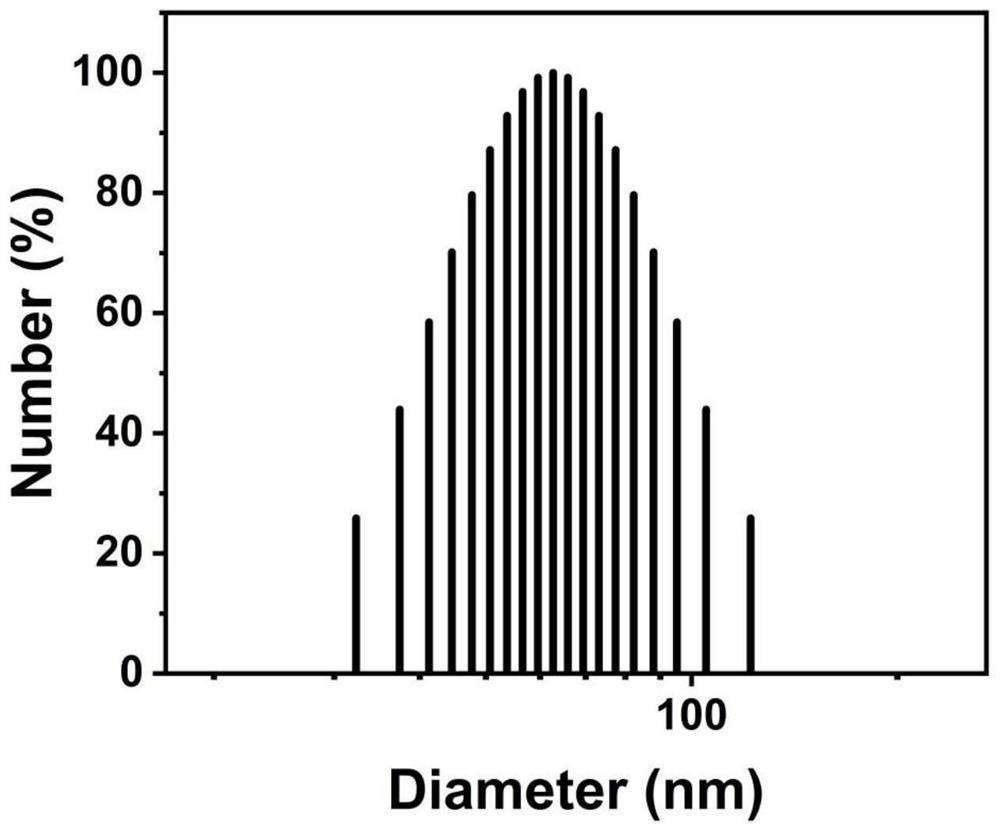Porous rhodium nano-material as well as preparation method and anti-tumor application thereof
A nanomaterial and porous structure technology, applied in the field of nanobiomaterials, can solve the problem of anti-tumor application of porous rhodium nanomaterials, and achieve excellent photothermal treatment effect, enhancement effect, and the effect of reducing tissue damage.
- Summary
- Abstract
- Description
- Claims
- Application Information
AI Technical Summary
Problems solved by technology
Method used
Image
Examples
Embodiment 1
[0031] Step 1. Weigh 100mg sodium hexachlororhodium and add it to 10mL deionized water, fully dissolve to obtain solution I; weigh 120mg sodium ascorbate and add it to 10mL deionized water, fully dissolve to obtain solution II; weigh 30mg ethylene oxide -b-Add polymethyl methacrylate to 6mL N,N-dimethylformamide, fully dissolve it, then gradually add it dropwise to 4mL deionized water, and stir at 500rpm to obtain solution III.
[0032] Step 2. Add solution I dropwise to solution III gradually, while stirring at 500rpm; stop stirring after dropping, and let it stand at room temperature for 20 minutes, quickly add solution II to the mixed solution, shake it evenly, and place it at 60°C After reacting for 10 hours in a water bath, take it out to cool and centrifuge to obtain a solid precipitate.
[0033] Step 3. Wash and centrifuge the solid precipitate obtained in step 2 (after washing and centrifuging three times with N,N-dimethylformamide, and then washing and centrifuging th...
Embodiment 2
[0036] Step 1. Weigh 150mg sodium hexachlororhodium and add it to 10mL deionized water, fully dissolve to obtain solution I; weigh 180mg sodium ascorbate and add it to 10mL deionized water, fully dissolve to obtain solution II; weigh 50mg ethylene oxide -b-Add polymethyl methacrylate to 6mL N,N-dimethylformamide, fully dissolve it, then gradually add it dropwise to 4mL deionized water, and stir at 600rpm to obtain solution III.
[0037] Step 2. Add solution Ⅰ dropwise to solution Ⅲ gradually, while maintaining stirring at 800rpm; stop stirring after dropping, and let it stand at room temperature for 20 minutes, quickly add solution Ⅱ to the mixed solution, shake it evenly and place it at 60°C After reacting for 12 hours in a water bath, take it out for cooling and centrifugation to obtain a solid precipitate.
[0038] Step 3. Wash and centrifuge the solid precipitate obtained in step 2 (after washing and centrifuging three times with N,N-dimethylformamide, and then washing and...
Embodiment 3
[0041] Step 1. Weigh 200mg sodium hexachlororhodium and add it to 10mL deionized water, fully dissolve to obtain solution I; weigh 240mg sodium ascorbate and add it to 10mL deionized water, fully dissolve to obtain solution II; weigh 70mg ethylene oxide -b-Add polymethyl methacrylate to 6mL N,N-dimethylformamide, fully dissolve it, then gradually add it dropwise to 4mL deionized water, and stir at 600rpm to obtain solution III.
[0042] Step 2. Add solution Ⅰ to solution Ⅲ step by step, while stirring at 1000rpm; stop stirring after dropping, and let it stand at room temperature for 20 minutes, quickly add solution Ⅱ to the mixed solution, shake it evenly and place it at 60°C After reacting for 14 hours in a water bath, take it out for cooling and centrifugation to obtain a solid precipitate.
[0043] Step 3. Wash and centrifuge the solid precipitate obtained in step 2 (after washing and centrifuging three times with N,N-dimethylformamide, and then washing and centrifuging thr...
PUM
| Property | Measurement | Unit |
|---|---|---|
| particle diameter | aaaaa | aaaaa |
| pore size | aaaaa | aaaaa |
| diameter | aaaaa | aaaaa |
Abstract
Description
Claims
Application Information
 Login to View More
Login to View More - Generate Ideas
- Intellectual Property
- Life Sciences
- Materials
- Tech Scout
- Unparalleled Data Quality
- Higher Quality Content
- 60% Fewer Hallucinations
Browse by: Latest US Patents, China's latest patents, Technical Efficacy Thesaurus, Application Domain, Technology Topic, Popular Technical Reports.
© 2025 PatSnap. All rights reserved.Legal|Privacy policy|Modern Slavery Act Transparency Statement|Sitemap|About US| Contact US: help@patsnap.com



